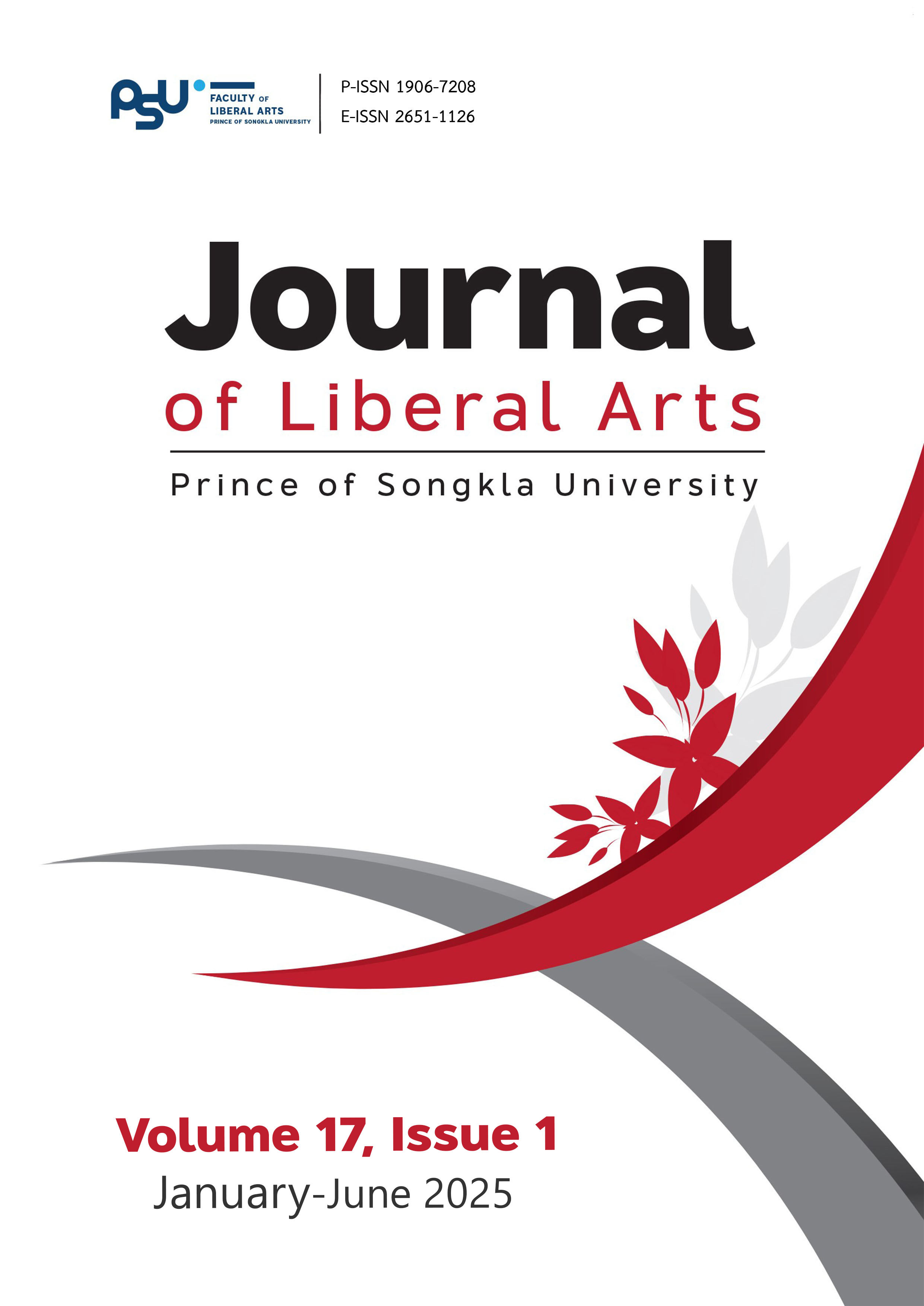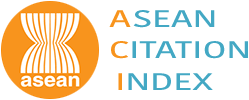An Exploration of the Interrelationship Between Language and Identity in Thai and English: An Ethnographic Study of Native Thai English Teachers
DOI:
https://doi.org/10.14456/jlapsu.2025.8Keywords:
Language, Identity, Interrelationship, Ethnographic StudyAbstract
This study explores the interrelationship between language and identity among native Thai English teachers who use both Thai and English. While extensive research exists on Thai and English pedagogy in Thailand, little is known about how language and identity interact. To address this gap, the study employed an ethnographic approach with an emic perspective and purposive sampling to examine the communicative behaviors and identities of three Thai English teachers. Grounded in identity theory and social identity theory, field observations were conducted at a Bangkok public secondary school, where Thai is the primary language and English is used as a second language within the language department. Each participant was observed for seven working days to understand their language use, behaviors, and identity shifts in daily interactions.
Findings revealed that all participants skillfully adjusted their language and communication styles depending on context and interlocutors. They shared the ability to shift between Thai and English to express different identities, prioritizing team spirit over nationality. However, they differed in adaptability and communication style. Some participants seamlessly alternated languages, while others maintained more structured usage. Additionally, their identity expression varied, with some emphasizing professional roles and others blending personal and professional identities. These variations highlight the fluid connection between language and identity.
References
Ambele, E. A., & Boonsuk, Y. (2021). Voices of learners in Thai ELT classrooms: A wake-up call towards teaching English as a lingua franca. Asian Englishes, 23(2), 201–217. https://doi.org/10.1080/13488678.2020.1759248
Ashmore, R. D., Deaux, K., & McLaughlin-Volpe, T. (2004). An organizing framework for collective identity: Articulation and significance of multidimensionality. Psychological Bulletin, 130(1), 80–114. https://doi.org/10.1037/0033-2909.130.1.80
Bradatan, C., Popan, A., & Melton, R. (2010). Transnationality as a fluid social identity. Social Identities, 16(2), 169–178. https://doi.org/10.1080/13504631003688856
Burnard, P., & Naiyapatana, W. (2004). Culture and communication in Thai nursing: a report of an ethnographic study. International Journal of Nursing Studies, 41(7), 755–765. https://doi.org/10.1016/j.ijnurstu.2004.03.002
Byram, M. (2006). Living and studying abroad: Research and practice. Multilingual Matters. https://doi.org/10.21832/9781853599125
D’Anna, L. H., Hansen, M., Mull, B., Canjura, C., Lee, E., & Sumstine, S. (2018). Social discrimination and health care: A multidimensional framework of experiences among a low-income multiethnic sample. Social Work in Public Health, 33(3), 187–201. https://doi.org/10.1080/19371918.2018.1434584
Edwards, D. (2009). Language and social interaction. SAGE Publications.
Edwards, J. (2009). Language and identity: An introduction. Cambridge University Press. https://doi.org/10.1017/CBO9780511809842
Erickson, F. (1992). Ethnographic microanalysis of interaction. In M. D. LeCompte, W. L. Millroy, & J. Preissle (Eds.), The handbook of qualitative research in education (pp. 201–225). Academic Press.
Goffman, E. (1963). Embarrassment and social organization. In N. J. Smelser & W. T. Smelser (Eds.), Personality and social systems (pp. 541–548). Wiley.
Gumperz, J. J. (1982). Language and social identity. Cambridge University Press. https://doi.org/10.1017/CBO9780511620836
Hall, E. T. (1976). Beyond culture. Anchor Books.
Hofstede, G. (1980). Culture’s consequences: International differences in work-related values. SAGE Publications.
Hogg, M. A., Abrams, D., Otten, S., & Hinkle, S. (2004). The social identity perspective: Intergroup relations, self-conception, and small groups. Small Group Research, 35(3), 246–276. https://doi.org/10.1177/1046496404263424
Jackson, J. W., & Smith, E. R. (1999). Conceptualizing social identity: A new framework and evidence for the impact of different dimensions. Personality and Social Psychology Bulletin, 25(1), 120–135. https://doi.org/10.1177/0146167299025001010
Jenkins, J. (2007). English as a lingua franca: Attitude and identity. Oxford University Press.
Joseph, J. (2004). Language and identity: National, ethnic, religious. Palgrave Macmillan. https://doi.org/10.1057/9780230503427
Knutson, T. J., Komolsevin, R., Chatiketu, P., & Smith, V. R. (2003). A cross-cultural comparison of Thai and U.S. American rhetorical sensitivity: Implications for intercultural communication effectiveness. International Journal of Intercultural Relations, 27(1), 63–78. https://doi.org/10.1016/S0147-1767(02)00062-0
Kosonen, K. (2008). Literacy in local languages in Thailand: Cultural maintenance, empowerment, or development? International Journal of Bilingual Education and Bilingualism, 11(2), 222–236. https://doi.org/10.2167/beb493.0
Layder, D. (1994). Understanding social theory. SAGE Publications.
Levine, J. M., & Moreland, R. L. (1998). Small groups. In D. T. Gilbert, S. T. Fiske, & G. Lindzey (Eds.), The handbook of social psychology (4th ed., pp. 415–469). McGraw-Hill.
Matthews, G., Deary, I. J., & Whiteman, M. C. (2003). Personality traits (2nd ed.). Cambridge University Press.
Mahayussnan, M. H. (2021). Cultural identity and social integration among immigrants in Malaysia [Master’s thesis, University of Malaya]. UM e-Theses Repository.
Mazak, C. M. (2012). My cousin talks bad like you: Relationships between language and identity in a rural Puerto Rican community. Journal of Language, Identity & Education, 11(1), 35–51. https://doi.org/10.1080/15348458.2012.644066
Meyerhoff, M. (2006). Linguistic change, sociohistorical context, and theory-building in variationist linguistics: New-dialect formation in New Zealand. English Language & Linguistics, 10(1), 173–194. https://doi.org/10.1017/S1360674306001796
Pérez-Milans, M. (2016). Language and identity in linguistic ethnography. In S. Preece (Ed.), The Routledge handbook of language and identity (pp. 83–97). Routledge.
Phillipsen, G., Coutu, L. M., & Covarrubias, P. (2005). Speech codes theory: Restatement, revisions, and responses to criticisms. In W. B. Gudykunst (Ed.), Theorizing about intercultural communication (pp. 55–68). SAGE Publications.
Sirikanchana, P. (2018). Preserving cultural identity in an interconnected world: The case of Thailand. The Journal of the International Association of Buddhist Universities, 11(3), 479. https://so06.tci-thaijo.org/index.php/Jiabu/article/view/219854
Smalley, W. A. (1994). Linguistic diversity and national unity: Language ecology in Thailand. University of Chicago Press.
Spradley, J. P. (1980). Participant observation. Holt, Rinehart, and Winston.
Spencer-Oatey, H., & Franklin, P. (2009). Intercultural interaction: A multidisciplinary approach to intercultural communication. Palgrave Macmillan. https://doi.org/10.1057/9780230244511
Tajfel, H. (1978). Differentiation between social groups: Studies in the social psychology of intergroup relations. Academic Press.
Tantiwich, W., & Sinwongsuwat, K. (2021). Intercultural communication competence: Thai and international students in university contexts. Journal of Intercultural Communication Research, 50(2), 1–18. https://www.tandfonline.com/doi/full/10.1080/17475759.2021.1895603
Tiewcharoenkij, A., Kanokkamalade, V., & Pankhuenkhat, R. (2022). The evolution of Thai language. The Journal of Sirindhornparithat, 23(1), 364–375. https://so06.tci-thaijo.org/index.php/jsrc/article/view/248987
Trakulkasemsuk, W. (2012). Thai English. In E.-L. Low & A. Hashim (Eds.), English in Southeast Asia: Features, policy and language in use (pp. 101–111). John Benjamins. https://doi.org/10.1075/veaw.g42.10tra
Trakulkasemsuk, W. (2018). English in Thailand: Looking back to the past, at the present, and towards the future. Asian Englishes, 20(2), 96–105. https://doi.org/10.1080/13488678.2017.1421602
Watzlawick, P., & Beavin, J. (1967). Some formal aspects of communication. American Behavioral Scientist, 10(8), 4–8. https://doi.org/10.1177/0002764201000802
Downloads
Published
How to Cite
Issue
Section
License
Copyright (c) 2025 Khawn Aung, Wannapa Trakulkasemsuk

This work is licensed under a Creative Commons Attribution-NonCommercial-NoDerivatives 4.0 International License.
The authors retain the copyright to their article but the Journal of Liberal Arts, Prince of Songkla University reserves the exclusive rights to first publication.






